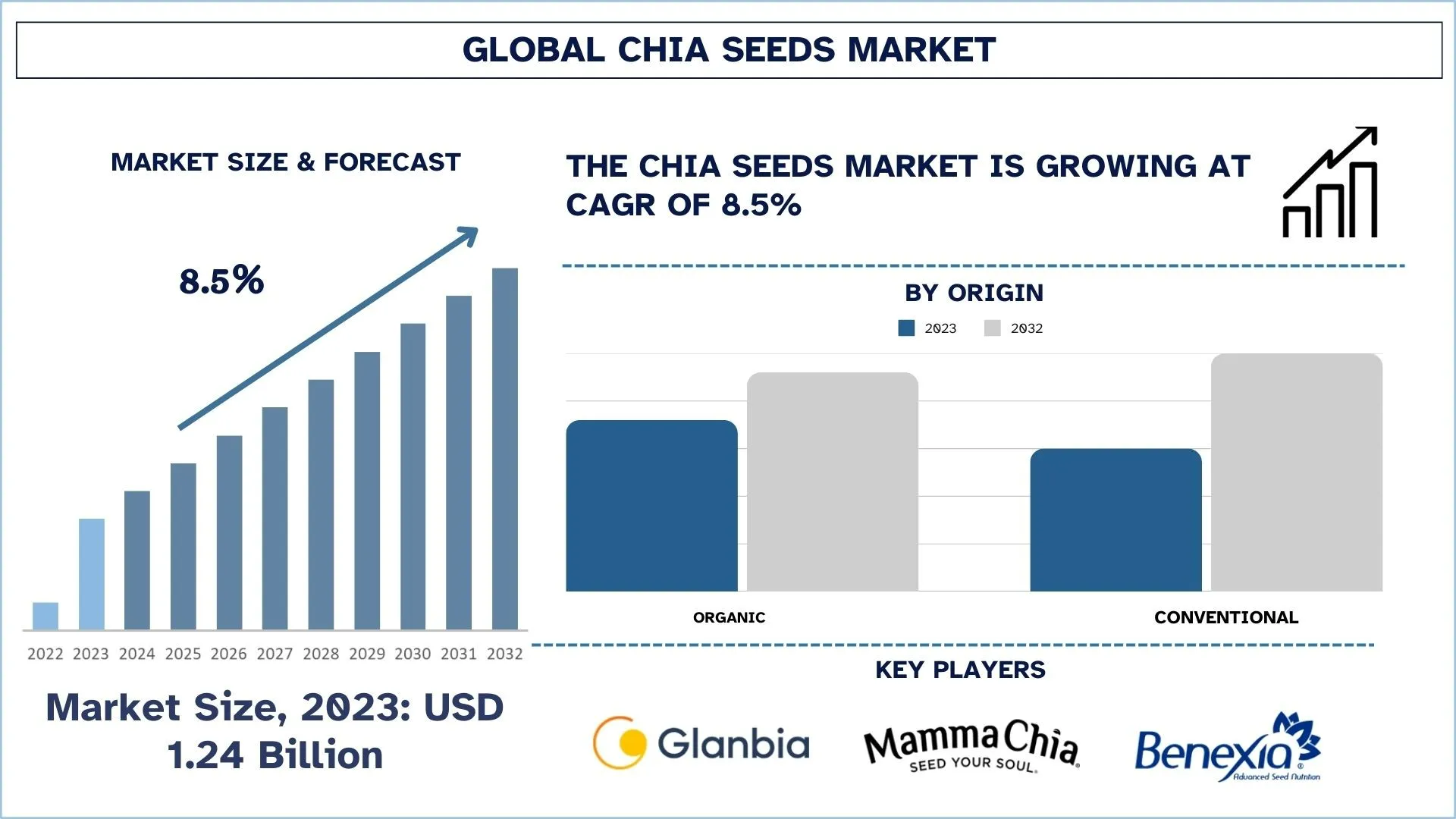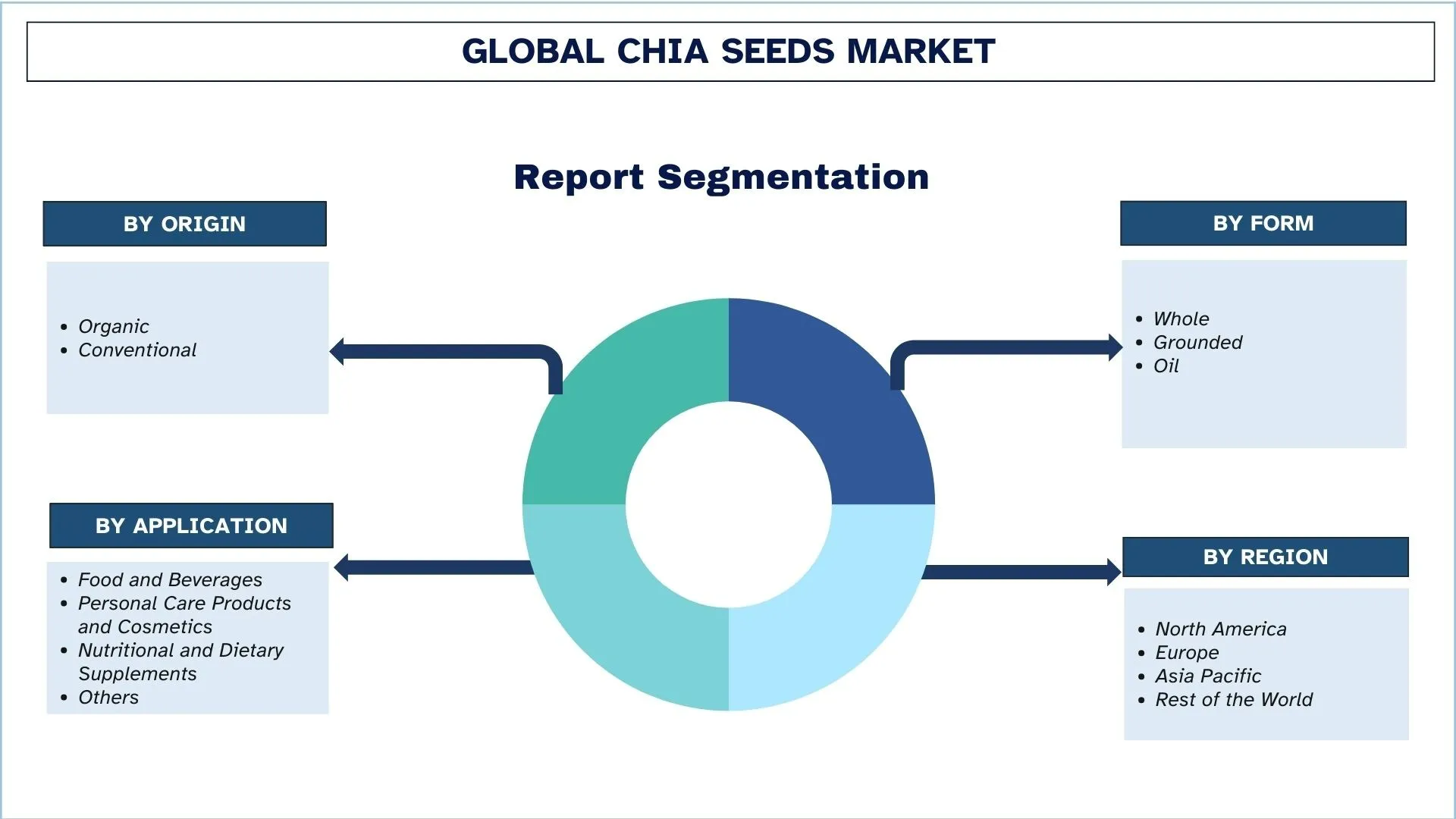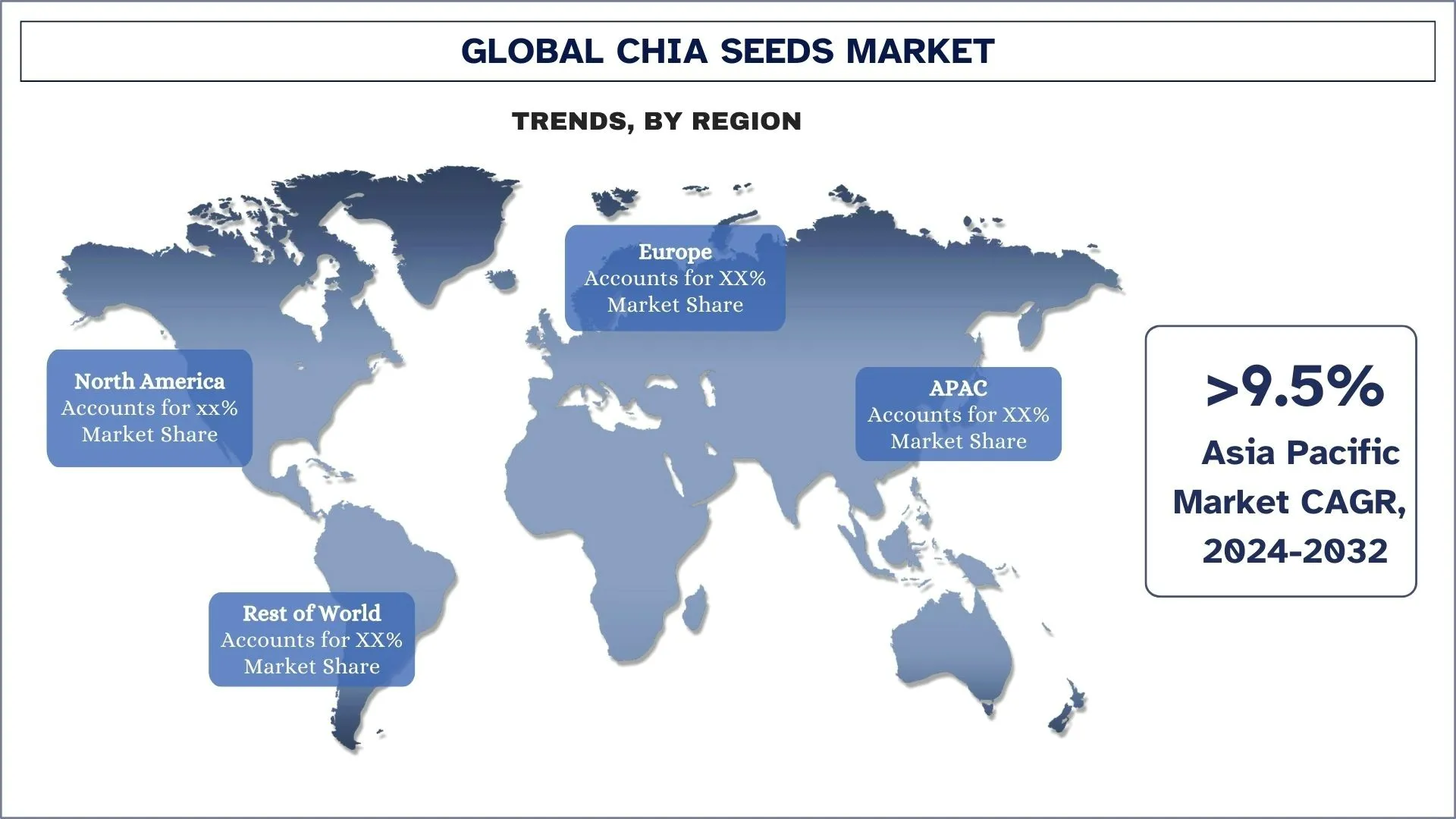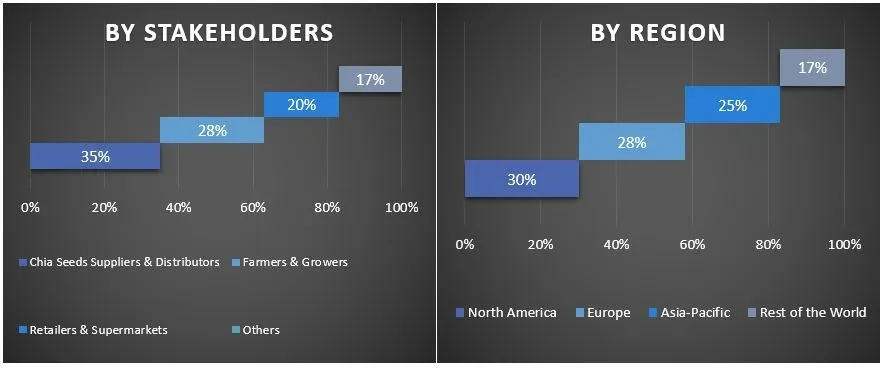- Home
- About Us
- Industry
- Services
- Reading
- Contact Us
Chia Seeds Market: Current Analysis and Forecast (2024-2032)
Emphasis on Origin (Organic and Conventional), Form (Whole, Grounded, and Oil), Application (Food and Beverages, Personal Care Products and Cosmetics, Nutritional and Dietary Supplements, and Others); and Region/Country

Chia seeds Market Size & Forecast
The chia seeds market was valued at approximately USD 1.24 billion in 2023 and is expected to grow at a substantial CAGR of around 8.5% during the forecast period (2024-2032) owing to rapid urbanization, busy lifestyle, rising consumer demand for healthy and nutritional food, and increased focus of vegan people on plant-based diet.
Chia Seeds Market Analysis
Chia seeds naturally grow from the Salvia hispanica plant in the Central and South America regions. Chia seeds are also known as superfoods because of their nutritional contents such as fiber, protein, omega-3 fatty acids, antioxidants, and essential minerals. The nutrients found in Chia seeds create several health advantages such as better digestion and cardiovascular wellness and assist in weight control. The nutritional benefits of Chia seeds enable their use throughout many different food types including smoothies yogurt oatmeal baked products and salads. The addition of liquid to these seeds produces a gel-like texture which enhances their wide use in puddings as well as acts as a substitute for vegan eggs. Chia seeds benefit athletic performance because of their hydrating properties leading to increased popularity among fitness enthusiasts. The global market for superfoods and functional foods relies on chia seeds because of their user-friendly approach, age-long durability, and outstanding wellness advantages.
The chia seeds market is driven by increased consumer awareness regarding the multiple health benefits of chia seeds in supporting heart wellness and promoting weight loss. The increasing vegan and vegetarian population led to chia seeds market expansion, as people are increasingly choosing plant-based and gluten-free diets. The widespread use of chia seeds in functional foods, beverages, dietary supplements, and personal care products is influencing health-conscious consumers to select chia seeds-based food products in their diet. Moreover, superfoods and clean-label products drive overall market expansion because of growing consumer demand. Rapid urbanization, shifting lifestyle patterns, and increasing preference for easy-to-consume nutritious snacks drive consumption rates higher. Through e-commerce platforms, manufacturers are extending terminal points and delivery systems that are positively promoting global market expansion.

Chia Seeds Market Trends
This section discusses the key market trends influencing the various segments of the chia seeds market as identified by our research experts.
Sustainable & Ethical Sourcing
Sustainability and ethical sourcing are becoming an important future trend for the chia seeds market as the consumer’s awareness level is rising and they prefer products that are environmentally friendly as well as socially responsible. Concerns have risen regarding the negative effects that agriculture has on the environment thus companies have been shifting towards socially accepted agricultural practices like organic farming, crop rotation, and water-saving methods. To some extent, ethical sourcing also empowers farmers who are involved in chia seeds farming. Most of them are located in the Latin America and Asia-Pacific region. Some of the certifications such as the Fair-Trade certification and the USDA Organic certification are gaining significance as consumers want to know the origin of their food. Due to this, companies that practice environmentally friendly packaging, carbon neutral management, and responsible sourcing of ingredients for chia seeds are bound to hold a significant market share in the chia seeds market.
Asia-Pacific is expected to be the fastest-growing region
The chia seeds market is expected to show significant market expansion in the Asia-Pacific region because of increased health awareness among consumers, rising incomes, and increasing consumer focus on plant-based diets. Consumers from China, India, and other countries are gaining interest in healthy foods, resulting in elevated demand for superfoods which include chia seeds as the main ingredients. Chia seed consumption continues to rise as people transition to vegetarianism and veganism and adopt gluten-free diets since these seeds provide protein, fiber, and omega-3 fatty acids. The presence of e-commerce platforms serves as a significant driver of chia seed market expansion in the APAC region through their successful delivery of products to consumers from all parts of urban and rural areas. Additionally, governments across the region support nutritious eating habits which enhances the market demand for nutrient-rich foods. All these factors are driving the growth of the chia seeds market in the APAC region.

Chia Seeds Industry Overview
The chia seeds market is competitive, with several global and international players. The key players are adopting different growth strategies to enhance their market presence, such as partnerships, agreements, collaborations, new nutritional food product launches, geographical expansions, and mergers and acquisitions. Some of the major players operating in the market are Glanbia Plc., Mamma Chia, BENEXIA, Salba Smart Natural Products, Nutiva Inc., K V Agro Products, The Chia Co., Healthworks, Viva Naturals Inc., Bata Food companies.
Chia Seeds Market News
- In August 2024 – Benexia® and Golden Omega, both Chilean-based companies in Arica, announced their strategic partnership, bringing Benexia chia seed oil and Golden Omega's extensive network to the North American market.
- In February 2022 - Mamma Chia, creator and leading brand of organic, plant-based beverages and snacks powered by chia, announced that its popular “Chia Vitality Beverages” and “Chia Energy Beverages” have transformed into keto-friendly, with just 6 grams of net carbs per serving. Total sugar has been reduced to just 3-4g per bottle. These chia beverages are packed with 3200-3400mg of heart and brain-healthy Omega-3, 3g of plant-based protein, 21% of daily dietary fiber, calcium, magnesium, and antioxidants.
Chia Seeds Market Report Coverage
Report Attribute | Details |
Base year | 2023 |
Forecast period | 2024-2032 |
Growth momentum | Accelerate at a CAGR of 8.5% |
Market size 2023 | USD 1.24 Billion |
Regional analysis | North America, Europe, Asia-Pacific, Rest of the World |
Major contributing region | Asia-Pacific is expected to grow at the highest CAGR during the forecasted period. |
Key countries covered | U.S., Canada, Germany, France, UK, Spain, Italy, China, Japan, and India |
Glanbia Plc., Mamma Chia, BENEXIA, Salba Smart Natural Products, Nutiva Inc., K V Agro Products, The Chia Co., Healthworks, Viva Naturals Inc., Bata Food companies. | |
Report Scope | Market Trends, Drivers, and Restraints; Revenue Estimation and Forecast; Segmentation Analysis; Demand and Supply Side Analysis; Competitive Landscape; Company Profiling |
Segments Covered | By Origin, Form, By Application, By Region/Country |
Reasons to buy this report:
- The study includes market sizing and forecasting analysis validated by authenticated key industry experts.
- The report presents a quick review of overall industry performance at one glance.
- The report covers an in-depth analysis of prominent industry peers with a primary focus on key business financials, product portfolios, expansion strategies, and recent developments.
- Detailed examination of drivers, restraints, key trends, and opportunities prevailing in the industry.
- The study comprehensively covers the market across different segments.
- Deep dive regional level analysis of the industry.
Customization Options:
The global chia seeds market can be customized further as per the requirement or any other market segment. Besides this, UMI understands that you may have your own business needs, hence feel free to connect with us to get a report that completely suits your requirements.
Table of Content
Research Methodology for the Chia Seeds Market Analysis (2022-2032)
Analyzing the historical market, estimating the current market, and forecasting the future market of the global chia seeds market were the three major steps undertaken to create and analyze the application of chia seeds in major regions globally. Exhaustive secondary research was conducted to collect the historical market figures and estimate the current market size. Secondly, to validate these insights, numerous findings and assumptions were taken into consideration. Moreover, exhaustive primary interviews were also conducted with industry experts across the value chain of the global chia seeds market. Post assumption and validation of market numbers through primary interviews, we employed a top-down/bottom-up approach to forecasting the complete market size. Thereafter, market breakdown and data triangulation methods were adopted to estimate and analyze the market size of segments and sub-segments of the industry. Detailed methodology is explained below:
Analysis of Historical Market Size
Step 1: In-Depth Study of Secondary Sources:
A detailed secondary study was conducted to obtain the historical market size of the chia seeds market through company internal sources such as annual reports & financial statements, performance presentations, press releases, etc., and external sources including journals, news & articles, government publications, competitor publications, sector reports, third-party database, and other credible publications.
Step 2: Market Segmentation:
After obtaining the historical market size of the chia seeds market, we conducted a detailed secondary analysis to gather historical market insights and share for different segments & sub-segments for major regions. Major segments are included in the report as origin, form, application, and regions. Further country-level analyses were conducted to evaluate the overall adoption of chia seeds in that region.
Step 3: Factor Analysis:
After acquiring the historical market size of different segments and sub-segments, we conducted a detailed factor analysis to estimate the current market size of the chia seeds market. Further, we conducted factor analysis using dependent and independent variables such as origin, form, application, and regions of the chia seeds market. A thorough analysis was conducted for demand and supply-side scenarios considering top partnerships, mergers and acquisitions, business expansion, and product launches in the chia seeds market across the globe.
Current Market Size Estimate & Forecast
Current Market Sizing: Based on actionable insights from the above 3 steps, we arrived at the current market size, key players in the global chia seeds market, and market shares of the segments. All the required percentage shares split, and market breakdowns were determined using the above-mentioned secondary approach and were verified through primary interviews.
Estimation & Forecasting: For market estimation and forecast, weights were assigned to different factors including drivers & trends, restraints, and opportunities available for the stakeholders. After analyzing these factors, relevant forecasting techniques i.e., the top-down/bottom-up approach were applied to arrive at the market forecast for 2032 for different segments and sub-segments across the major markets globally. The research methodology adopted to estimate the market size encompasses:
- The industry’s market size, in terms of revenue (USD) and the adoption rate of the chia seeds market across the major markets domestically.
- All percentage shares, splits, and breakdowns of market segments and sub-segments.
- Key players in the global chia seeds market in terms of products offered. Also, the growth strategies adopted by these players to compete in the fast-growing market.
Market Size and Share Validation
Primary Research: In-depth interviews were conducted with the Key Opinion Leaders (KOLs) including Top Level Executives (CXO/VPs, Sales Head, Marketing Head, Operational Head, Regional Head, Country Head, etc.) across major regions. Primary research findings were then summarized, and statistical analysis was performed to prove the stated hypothesis. Inputs from primary research were consolidated with secondary findings, hence turning information into actionable insights.
Split of Primary Participants in Different Regions

Market Engineering
The data triangulation technique was employed to complete the overall market estimation and to arrive at precise statistical numbers for each segment and sub-segment of the global Chia seeds market. Data was split into several segments and sub-segments after studying various parameters and trends in origin, form, application, and regions of the global chia seeds market.
The main objective of the Global Chia Seeds Market Study
The current & future market trends of the global chia seeds market were pinpointed in the study. Investors can gain strategic insights to base their discretion for investments on the qualitative and quantitative analysis performed in the study. Current and future market trends determined the overall attractiveness of the market at a regional level, providing a platform for the industrial participant to exploit the untapped market to benefit from a first-mover advantage. Other quantitative goals of the studies include:
- Analyze the current and forecast market size of the chia seeds market in terms of value (USD). Also, analyze the current and forecast market size of different segments and sub-segments.
- Segments in the study include areas of origin, form, application, and regions.
- Define and analyze the regulatory framework for the chia seeds
- Analyze the value chain involved with the presence of various intermediaries, along with analyzing customer and competitor behaviors of the industry.
- Analyze the current and forecast market size of the Chia seeds market for the major regions.
- Major countries of regions studied in the report include Asia Pacific, Europe, North America, and the Rest of the World.
- Company profiles of the chia seeds market and the growth strategies adopted by the market players to sustain the fast-growing market.
- Deep dive regional level analysis of the industry.
Frequently Asked Questions FAQs
Q1: What is the chia seeds market's current size and growth potential?
The chia seeds market was valued at USD 1.24 billion in 2023 and is expected to grow at a CAGR of 8.5% during the forecast period (2024-2032).
Q2: What are the driving factors for the growth of the chia seeds market?
The chia seeds market is majorly driven by rapid urbanization, shifting lifestyle patterns, and increasing preference for easy-to-consume nutritious snacks.
Q3: Which segment has the largest share of the chia seeds market by origin?
The conventional segment has the largest share of the chia seeds market by origin.
Q4: What are the major trends in the chia seeds market?
Increased application of chia seeds in fortified and functional foods, sustainable & ethical sourcing, and convenience-focused products are the major trends in the chia seeds market.
Q5: Which region will dominate the chia seeds market?
North America dominated the market in 2023.
Related Reports
Customers who bought this item also bought










